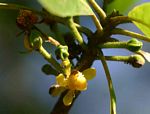Uapaca sansibarica
Selected images: Click on each image to see a larger version and details of the record View all images (8)
Detailed records: Display species records QDS maps by: Google Maps Point records by Google Maps
Species details: Click on each item to see an explanation of that item (Note: opens a new window)
| Synonyms: | |
| Common names: | Lesser mahobohobo (English) |
| Frequency: | Local |
| Status: | Native |
| Description: |
Small to medium-sized tree. Leaves clustered near the ends of branches, obovate, stiff and leathery, shiny green above, paler below. Flowers greenish-yellow; sexes mostly on different trees. Fruit fleshy spherical, yellow when ripe. |
| Type location: |
Syntypes from Tanzania, Mozambique and Malawi |
| Notes: | This species closely resembles Uapaca kirkiana but both leaves and fruits are considerably smaller; leaves are usually more shiny green; and it is a species of more restricted distribution in high rainfall, low altitude woodland. |
| Derivation of specific name: | |
| Habitat: | In deciduous woodland and bamboo thickets. |
| Altitude range: (metres) | |
| Flowering time: | Mar - Apr |
| Worldwide distribution: | Zambia, Angola, D. R. Congo, Tanzania, Malawi, Mozambique, Zimbabwe; throughout East Africa. |
| FZ divisions: | E |
| Growth form(s): | |
| Endemic status: | |
| Red data list status: | |
| Insects associated with this species: | Abantis bamptoni (Larval foodplant) |
| Spot characters: | Display spot characters for this species |
| Literature: |
Burrows, J.E., Burrows, S.M., Lötter, M.C. & Schmidt, E. (2018). Trees and Shrubs Mozambique Publishing Print Matters (Pty), Cape Town. Page 421. (Includes a picture). Chapano, C. & Mamuto, M. (2003). Plants of the Chimanimani District National Herbarium and Botanic Garden, Zimbabwe Page 57. Coates Palgrave, K. (revised and updated by Meg Coates Palgrave) (2002). Trees of Southern Africa 3rd edition. Struik, South Africa Drummond, R.B. (1975). A list of trees, shrubs and woody climbers indigenous or naturalised in Rhodesia. Kirkia 10(1) Page 251. Fowler, D.G. (2007). Zambian Plants: Their Vernacular Names and Uses, Kew Publishing Mapaura, A. & Timberlake, J. (eds) (2004). A checklist of Zimbabwean vascular plants Southern African Botanical Diversity Network Report No. 33 Sabonet, Pretoria and Harare Page 43. Ntore, S. & al. (2024). Checklist of the vascular plants of Burundi Page 188. Phiri, P.S.M. (2005). A Checklist of Zambian Vascular Plants Southern African Botanical Diversity Network Report No. 32 Radcliffe-Smith, A. (1996). Euphorbiaceae Flora Zambesiaca 9(4) Pages 98 - 100. (Includes a picture). Strugnell, A.M. (2006). A Checklist of the Spermatophytes of Mount Mulanje, Malawi Scripta Botanica Belgica 34 National Botanic Garden of Belgium Page 89. Wursten, B., Timberlake, J. & Darbyshire, I. (2017). The Chimanimani Mountains: an updated checklist. Kirkia 19(1) Page 97. |
Other sources of information about Uapaca sansibarica:
Our websites:
Flora of Burundi: Uapaca sansibaricaFlora of Malawi: Uapaca sansibarica
Flora of Mozambique: Uapaca sansibarica
Flora of Zambia: Uapaca sansibarica
External websites:
African Plants: A Photo Guide (Senckenberg): Uapaca sansibaricaAfrican Plant Database: Uapaca sansibarica
BHL (Biodiversity Heritage Library): Uapaca sansibarica
EOL (Encyclopedia of Life): Uapaca sansibarica
GBIF (Global Biodiversity Information Facility): Uapaca sansibarica
Google: Web - Images - Scholar
iNaturalist: Uapaca sansibarica
IPNI (International Plant Names Index): Uapaca sansibarica
JSTOR Plant Science: Uapaca sansibarica
Mansfeld World Database of Agricultural and Horticultural Crops: Uapaca sansibarica
Plants of the World Online: Uapaca sansibarica
Tropicos: Uapaca sansibarica
Wikipedia: Uapaca sansibarica

